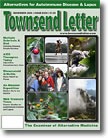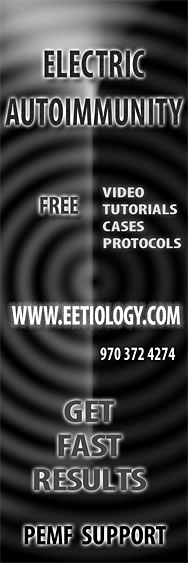| Page
1, 2
Obvious
Versus Stealth
Autoimmune disorders reflect a tendency to attack cells with no
obvious pathogens. The keyword here is obvious.
Figure
17: Viral Image
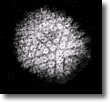
There are a wide range of pathogenic factors
that remain undetectable and unable to be tested using common laboratory
assays. Viral and other critters may, in fact, be resident inside
cells. There are many examples of dormant cells, like HIV, Herpes,
and Lyme parasites, which remain hidden beyond the reach of autoimmune
system.
Figure
18: Viral Core with Cell docking structures
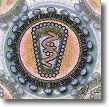
Figure
19: Serum Spiral Pathogens
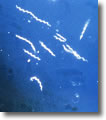
In other words, the inadequate or incomplete
immune response is a likely cofactor in the ongoing autoimmune challenges
faced by individuals with "autoimmune" conditions. Blaming
an "overactive" immune system for attacking "innocent"
cells is at best naïve. The diagnostic inability to identify
a pathogen doesn't mean that there isn't one.
A zoo of stealth pathogens often create curses
on the immune system, damned to pursue the unachievable in pursuit
of the unrecognizable. Allopathic autoimmune treatments disable
part of the immune system, normally inhibiting B-Cell synthesis
or crippling the TNF-mediated response.
The alert reader will find it curious that B-Cell interventions
take-out or inhibit B-Cell autoimmune response, which is directly
related to memory defense.
Autoimmune Neuropathology
Pathogens likely evolved to produce neurotoxins as a defense mechanism.
Disabling the brains of the immune system, specifically B- and T-cells,
inhibits immune response as a survival mechanism.
The strong similarity between immune system brain cells and the
nervous system cells explains the frequent coincidence of autoimmune
disorders and neuropathology. When pathogens that evolved to disable
the nerves of the immune system accumulate in the nervous system,
motor and cognitive neuropathology happens.
Cell Response and Cell Power
Cell energy is a critical factor in autoimmune conditions. Resources
that enable cells to do their proper job are essential and are usually
overlooked in the therapeutic process. Life is energy.
Many toxins undermine the energetic cellular processes. The gradual
degeneration of cellular energy, particularly of neuro-active cells,
enables pathogens to propagate against continuously lessening resistance,
commonly recognized as chronic progressive pathology common to autoimmune
disorders.
Bilateral energetic compromise of both immune cells, and non-immune
cells, driven by pathogens and their toxins, protect the culprits
and propagates the degeneration, which hallmarks the dismal prognosis
of autoimmune conditions.
Interventions that restore cellular energetic process tend to reverse
the trajectory in autoimmune conditions:
· Detoxification helps remove pathogenic chemicals that inhibit
natural cellular energy production;
· Immune support, instead of suppression, aids in overcoming
pathogens that produce the toxins;
· Nutrient support provides building materials to create
new healthy cells;
· Energetic support, enhances detoxification, and often lifts
the immune system enough to overcome pathogens and aids in damaged
cell regeneration.
PEMF Energy Pump
Cells are batteries. Adding energy lifts their performance toward
healthy levels. Pulsed magnetic fields pump usable energy into cells.
This energy enables many types of cells to compensate for damage
that resulted from toxic, pathogenic, or physical trauma.
Restored energetics often lift immunological performance, detoxification,
and functional cell performance toward healthy levels. In autoimmune
conditions, this lift often aids in stabilization or reversal of
autoimmune conditions.
Pulsed Immune Support
There is a natural correlation between size and frequency. Smaller
objects resonate at higher frequencies than large objects. This
is true mechanically and energetically.
Ringing and Pathogens
Biological tissues stimulated with raw pulse energy resonate at
their natural frequency.
Figure
20: Resonance Illustration
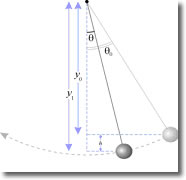
Reinforcing the natural resonance strengthens
the dominant organism. Similarly, strong master resonance creates
an inhibitory energetic disadvantage for pathogenic organisms by
disrupting non-harmonic, pathogenic elements.
Differential Pathogen Resonance
Pulsed fields assert differential effects on pathogens cells versus
host cells. While mammalian host cells tend to absorb pulse energy
and use it, parasitic organisms, which lack energetic resonance
with the host, experience stress.
Pulsed microbial inactivation, similar to pulse pasteurization,
illustrates the effect of differential resonance on a host body
and a parasite or pathogen. Acute pathogenic stress occurs when
the host energetically resonates strongly, and that resonance disrupts
the life processes of pathogens. Impulses ring the host at a host
frequency, and pathogens, which are energetically interdependent,
ring at a different frequency. When the frequencies collide, and
the intensity is sufficient, the pathogens life process often fails.
PEMF exposure also provides anti-pathogenic effects most clearly
documented in the ability to use PEMF as a sterilization and pasteurization
technique, NIH
References Here. It's very handy to be able to do in-vivo sterilization
and strengthen the host organism.
Figure
19: Parasitic form in biological medium
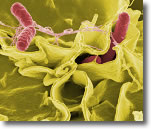
Tiny Pathogens
Tiny pathogens, like subcellular forms, respond less than cellular
and multiple cellular forms to pulsed energetics.The benefits of
PEMF appear to result more from lifting the host energetics, which,
in turn, enhances the host's natural defenses. New data, however,
strongly indicates that at shorter pulse-widths, in the range of
200 ns, exhibit suppressive effects on melanomas, multi-cellular
pathogens.
Immune Support Model
Pulsed Fields appear to support the immune system by the following:
· Disabling pathogens that match the waveform of the pulses,
large pathogens, bacteria as discussed earlier, respond to coarse
pulses;
· Smaller pathogens are increasingly disrupted by smaller
duration more intense pulses;
· Reducing the larger pathogenic forms supports the immune
system by reducing overall autoimmune load, freeing resources for
other anti-pathogen activities.
Pulsed Magnetic Fields and Biology
The situation in biological organisms is similar. The pulse is the
ringer, causing the body to ring strong at its natural frequency.
Anything that doesn't ring along, like pathogens, experience stress
and encounter an environmental disadvantage.
Electromagnetic Sensitivity Explained
Electrically weak individuals will ring loudly. This potent ringing
creates strong sensations. Individuals with electrically weak cells
tend to be more sensitive to pulsed fields because their cells respond
more readily to both beneficial and harmful radiation.
They tend to gain energy rapidly from pulsed fields that support
cellular metabolism. Likewise, they tend to resonate with harmful
radiations. Use of pulsed magnetic fields tends to decrease sensitivity
to detrimental electromagnetic radiation by strengthening the native
bio-field.
Autoimmune Cofactors
Diseases and the mistargeted cells:
· Multiple Sclerosis – attacks the cell membrane of
nerves causing degeneration in the myelin sheath. 1000+
NIH articles linking TNF and MS.
· Rheumatoid Arthritis – Attacks joints, typically
the synovium, appearing like the immune system has gone awry. Click
here to review 5000+ NIH articles linking TNF and RA.
· Lupus – seemingly attacks cells at random around
the body. Click
here to review 700+ NIH articles linking TNF and RA.
· Ankylosing Spondylitis – Attacks the spine causing
degeneration. Click
here to review 435+ NIH articles linking TNF and AS.
Each of these autoimmune disorders shares several curious attributes:
· Individuals with autoimmune diagnosis tend to have exhibit
potassium deficiency; click
here to review 208+ NIH articles linking autoimmune diseases and
potassium deficiency.
· Tests show elevations in Tumor Necrosis Factor;
· Symptoms respond to drugs that suppress TNF;
· Symptoms are eased by factors that suppress TNF, curcumin;
· Symptoms respond to drugs that inhibit B-cell responses;
The Potassium Mystery
Obscure references document the relationship for systemic potassium
deficiency and rheumatoid arthritis. Depressed system potassium
levels are consistent with virtually all autoimmune disorders. The
most visible telltale for anabolic metabolism dysfunction is visible
in blood tests:
· High serum potassium (above 4.5mEq) as the body ineffectively
elevates circulating potassium in attempt to increase cellular levels
(Revici), above;
· High red blood cell sedimentation rate, above 15 ml/hr;
· Low Eosinophilia levels, below 100 cmm;
· Low urinary pH, below 6.4;
· Low urinary surface tension;
· Low calcium or chloride excretion.
Generally, autoimmune disorders are predicated by a long-term history
of anabolic metabolism dysfunction. In many cases, there is a history
of poor sleep in women and accelerated aging in men. Unlike women,
men with a cellular anabolic imbalance tend to sleep because elevated
testosterone tends to enable sleep.
The Secret Potassium Source
Cellular potassium comes from the cold fusion of Na + O -> K
+ energy.
This well-documented secret was described and confirmed by Louis
Kervran and confirmed by Solomon Goldfein working for the US Army.
Goldfein also confirmed the fusion of Mg + O -> Ca + energy
Figure
21: Goldfein illustration coupled
ATP Cyclotron by US Army
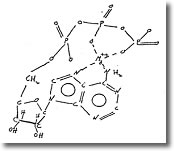
These two mineral conversion equations provide
a Rosetta Stone for irresolvable metabolic syndromes, including
autoimmune disorders and several forms of chronic fatigue.
Potassium Anabolism
The potassium fusion reaction, Na + O ? K, is a major driver in
the anabolic energy production. As anabolic energy production degenerates,
cellular and systemic potassium levels decline, resulting in a range
of conditions relating to the following:
· Anabolic Dysfunction – healing deficiency;
· Cellular Potassium Deficiency syndromes – particularly
neurological transmission dysfunctions resulting from axon potassium
deficiency;
· Neural hyper-excitability syndromes, epilepsy, tinnitus,
resulting from attenuated neural signal to neural noise ratios;
· Systemic Potassium Deficiency syndromes.
In the meantime, cellular mitochondria compensate, overworking,
and depleting magnesium reserves, and other oxygen-related metabolites.
Cellular sleep degenerates as mitochondrial energy production dominates
the life functions. Rest is rare and of poor quality.
Potassium and Autoimmune Symptoms
These references correlate depressed systemic potassium levels with
Rheumatoid Arthritis:
· Bone turnover in early rheumatoid arthritis
· LaCelle, P.L., et al., 1964. "An Investigation of
Total Body Potassium in Patients with Rheumatoid Arthritis."
Proc. Ann. Meeting of the Am. Rheumatism Assoc. Arth. Rheum. 7;
321.
In all cases, autoimmune diseases are preceded by breakdown in cellular
anabolic performance, and consequently, cellular potassium deficiency
is guaranteed in autoimmune disorders. The critical oversight in
research literature is that cellular potassium is a by-product of
anabolic metabolism.
Dietary potassium sources weakly influence cellular potassium levels
because the cellular potassium channels are one way out, not in.
Modest exceptions occur when dietary potassium is encapsulated,
chelated into aspartate, orotate forms, or lipid structures that
integrate with the cell membrane. Cellular potassium and eventually
systemic potassium levels drop because the process that creates
the potassium fails, not because potassium intake is deficient.
The biased view that potassium-related issues are always caused
by potassium channel dysfunction reflect the dominant oversight
that cellular potassium is a metabolic by-product.
Cellular Energetic Anabolism
PEMF exposure, which lifts the cellular energetics, especially the
transmembrane potential often helps to restart cellular anabolic
metabolism.
The electric fields across the cell membranes are huge, often exceeding
three million Volts / meter. Toxins that pollute the membrane dielectric
leak electricity and prevent development of higher membrane potential
that enables cellular anabolic performance.
The Anabolic Potassium Link
Anabolic failure, synonymous with long-term insomnia, precedes immunological
failure by years particularly in women.
Anabolic failure is typically due to toxins and pathogens that directly
undermine cellular of transmembrane potential, or TMP. TMP is critical
because it is the power supply for virtually all of the processes
that link cells to their operative roles in the body. When the power
is down, many cell functions don't work well.
Over time, failure of the anabolic process creates cellular potassium
deficiency and eventually systemic deficiency. Revici said that
cellular potassium deficiency is typically indicated by elevated
serum potassium levels as the body saturates the serum, attempting
to coax potassium back into the cells. Eventually, the body becomes
so potassium-depleted, it fails to be able to maintain serum levels,
and the breakdown progresses to subsequent levels.
Lupus and RA
Lupus is weakly differentiated from Rheumatoid Arthritis. Symptomatic
differentiation between the two conditions relates to the location
tendency of inflammation symptoms. Lupus floats, while Rheumatoid
Arthritis affects primarily joint tissue.
Eighty percent of adults with rheumatoid arthritis test positive
for rheumatoid factor. Moreover, individuals with Lupus frequently
test positive for rheumatoid factor.
Therapeutic Response Model
The approach suggested in this essay seeks to improve the cell membrane
voltage by correcting systemic and nutritional factors that compromise
cell membrane power.
TNF autoimmune triggering targets electrically weak cells. Electrically
weak cells result from deficiency in cellular power. Restoration
of normal cellular energy is broadly effective at restoring autoimmune
mistargeting.
Generally, protocols that restore cellular power production reduce
the tendency for immune mistargeting.
Cell
power restoration is broadly effective at treating autoimmune
disorders.
Autoimmune Syndromes
The pattern in autoimmune syndromes is generally the same:
1. Toxins or other factors cause compromised cell membrane performance,
2. resulting in low cell membrane voltage (low membrane voltage
is common to most cancer cells).
3. Low cell membrane voltage creates vulnerability to Tumor Necrosis
Factor, TNF, autoimmune response.
4. TNF activation causes inflammatory and immune response.
Neurological autoimmune syndromes usually have symptoms from neural
potassium deficiency, resulting from compromised anabolism. Neural
potassium deficiency causes degenerate impulse transmission through
nerves.
Rheumatoid Arthritis / Ankylosing Spondylitis:
1. Synovium cells surrounding joints become weakened due to age,
stress, or other environmental factors,
2. resulting in a disrupted anabolic energy production,
3. resulting in cell membrane potential falling below the trigger
threshold for TNF triggering.
4. B-cells initiate immune response on tagged cells, causing destruction
of these cells.
5. The body deposits calcium to isolate the rest of the body from
the diseased cells.
Multiple Sclerosis
1. Nerve cell sheaths become weakened due to pathogenic or systemic
toxin accumulation,
2. resulting in a disrupted anabolic energy production,
3. which causes a decline in intra-neural potassium,
4. which causes a decrease in the ability of the nerve to carry
impulses.
5. As the condition worsens, due to systemic degeneration and toxins
accumulating in the nerve sheath (cell membrane), intracellular
potassium deficiency accumulates,
6. resulting in a continuous deterioration of neural function,
7. and also resulting in cell membrane potential falling below the
trigger threshold for TNF activation.
8. B-cells initiate immune response on tagged cells, causing destruction
of these cells and
9. accelerating neural destruction in advanced disease stages.
Lupus Erythematosus
1. A group of cells become weakened due to age, stress, or other
environmental factors,
2. resulting in a disrupted anabolic energy production,
3. resulting in cell membrane potential falling below the trigger
threshold for TNF triggering.
B-cells initiate immune response on tagged cells
Autoimmune Cofactor Candidates
| Cofactor |
Role |
Supports |
| Cell Membrane Integrity |
Defines the ability for cells to maintain
electrical integrity. |
All hormonal and electrical integrity
of the cell. |
| Intra/Extra cellular pH differential
|
Creates energy for cell membrane functions,
hormone receptors, and autoimmune cell evaluation. |
Autoimmune sensing of diseased cells. |
| Ambient Autoimmune Load |
Determines the resources available to
support normal autoimmune performance. |
Autoimmune resources to available to
eradicate stealth and other pathogens. |
| Stealth Pathogen Prevalence |
Absorbs autoimmune resources. |
|
| 1,25-dihydroxyvitamin-D in response to
intracellular bacteria |
Describes masking mechanism used by intra-cellular
bacteria/mycoplasma evade autoimmune eradication. |
See
Marshall protocol |
|
For Protocol Information
Contact Whole Health Research Alliance, LLC
970 372 4274,
or email contact@eetiology.com
|
Author note: Artwork in this document is reproduced under GPL License
and may be reproduced from original sources at www.wikipedia.org.
Page 1,
2
|



![]()
![]()
![]()
